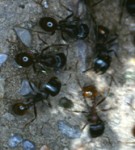
Click On Picture for Larger Image
Rough Harvester Ants
Author: Ray Bowers
 Click On Picture for Larger Image |
Species: Pogonomyremex rugosus |
Description:
Harvester ants are social insects with a red-brown to black body that is from 6 to 13mm ( 0.25 to 0.5in ) long depending on their caste. The head contains strong chewing mouthparts, medium sized eyes, elbowed antennae, and hairs on the underside of the head are used in carrying objects . The thorax has medium sized legs. The males and reproductive females are the only caste with four membranous wings, which are shed after mating. The workers are sterile females. There is a narrow connection between the thorax and abdomen that has an upright lobe. The abdomen of the females have a sting.
Geographic range:
Harvester ants are found worldwide, and are widespread across the Southwest. The rough harvester ant is found through New Mexico.
Habitat:
Harvester ants live in arid and semiarid areas. The number of colonies and size of the colonies is an indication of seed availability. The rough harvester ant is found through the Jornada Basin.
Food Web:
The harvester ants feed on seeds and plant materials. The seeds are collected and stored in the nest. The ants are in turn fed upon by a number of predators. One of the bird predators of the Jornada Basin is the curve-bill thrasher, and another predator is the horned lizard.
Reproduction and Development:
The male and reproductive female rough harvester ants emerge in the late summer after the summer rains for their mating flights. After the mating flight the males die and the females find a suitable site for a colony. Ants undergo a complete metamorphosis type of development. The queen cares for the first brood of workers, but after that the workers take care of the grub-like larva, and pupa stages.
| Behavior: The harvester ants will clear a circular area around the colony and aggressively remove any plants that start to grow in the area. As their name implies the workers spread out from the colony to harvest plants and seeds, which are stored in the nest. Harvester ants use chemical secretion to communicate within or outside of the colony. The secretions may be used to leave trails or give an alarm. It has been observed that when the colony is under sever predation, the ants will remain inside of the colony. Harvester ants have a variety of defenses. The workers can sting or bite, and when the colony is being attacked they will swarm to the defense. |
 Click On Picture for Larger Image |
Ecosystem roles:
Harvester ants feed on seeds and plant material, and remove all plant material around the colony. They are in turn fed upon by vertebrates such as birds and lizards and other insects.
The passageways within the nest provide aeration of the soil as well as allowing water infiltration.
Other info:
Some nest can extend to ten feet below the surface.
Taxonomy:
Kingdom: Animalia
Phylum: Arthropoda
Subphylum: Atelocerata
Class: Hexapoda
Order: Hymenoptera
Family: Formicidae
Genus: Pogonomyremex
Species: Pogonomyremex rugosus
References:
Borror, Donald J. and Richard E. White. 1970. A Field Guide to the Insects of America North of Mexico. Boston : Houghton Mifflin Co.
Borror, Donald J., Charles A. Triplehorn, and Norman F. Johnson. 1989. An Introduction to the Study of Insects. Philadelphia: W. B. Saunders Co.
Bland, Roger G and H. E. Jaques.1978. How to Know Insects. Dubuque , Iowa : Wm. C. Brown Co.
Degenhardt, William G.,Charles W. Painter, and Andrew H. Price.1996. Amphibians and Reptiles of New Mexico . Albuquerque : University of New Mexico Press.
Larson, Peggy and Lane Larson. 1977. The Deserts of the Southwest. San Francisco : Sierra Club Books.
MacMahon. James A.1985. Deserts. New York : Alfred A Knopf, Inc.
New Mexico Game & Fish. 2000. Harvester ants, Pogonomyrmex. Biota Information System of New Mexico . www.fw.vt.edu/fishex/nmex_main/species/180010.htm
Peterson, Roger T and Virginia M. Peterson. 1990. A Field Guide to Western Birds. Boston : Houghton Mifflin Co.
Werner, Floyd and Carl Olson. 1994. Insects of the Southwest. Fisher Books, LLC.
Related Terms: Hexopoda, Insects